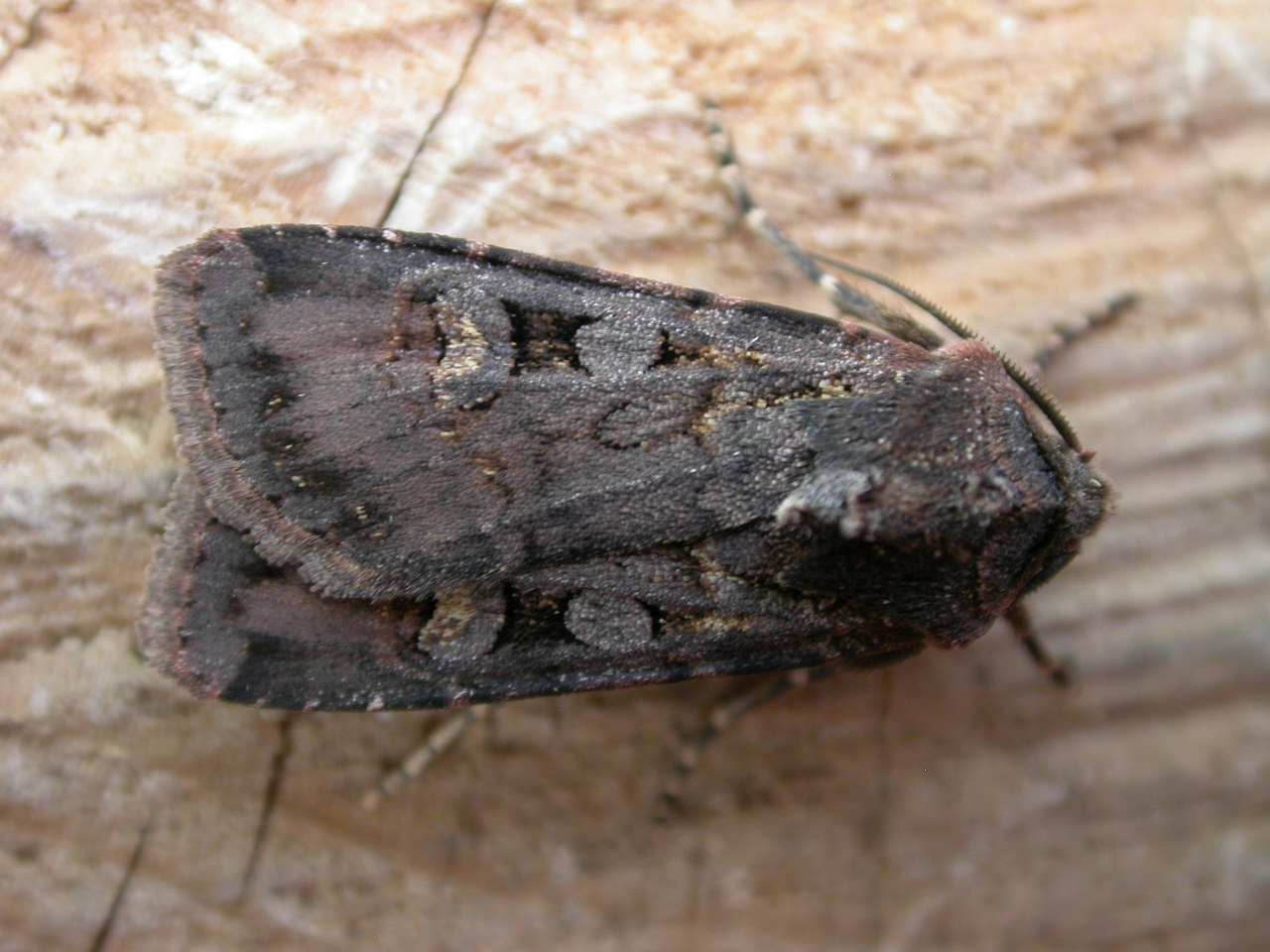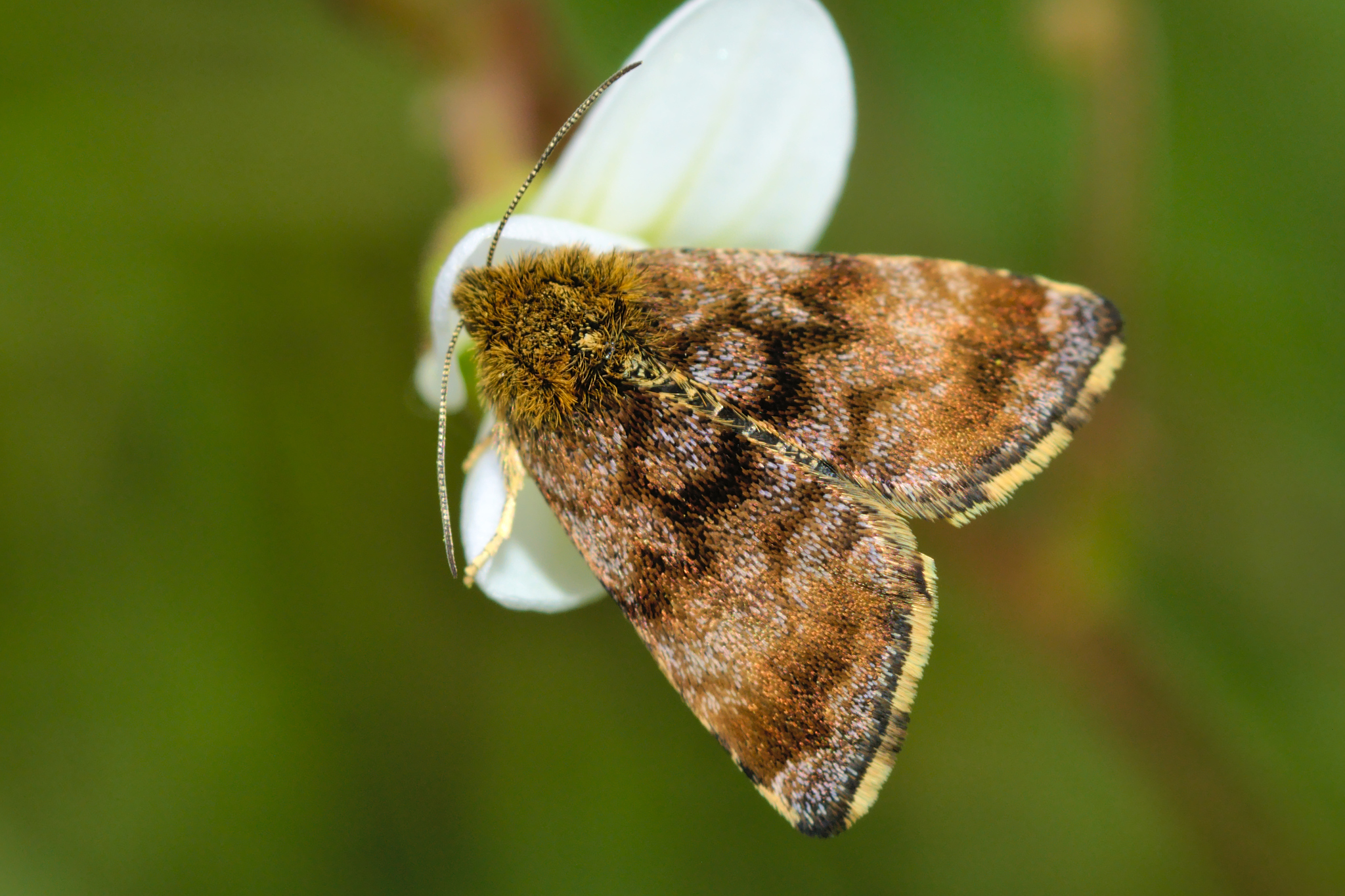|
Owlet Moth
The Noctuidae, commonly known as owlet moths, cutworms or armyworms, are a family of moths. They are considered the most controversial family in the superfamily Noctuoidea because many of the clades are constantly changing, along with the other families of the Noctuoidea. It was considered the largest family in Lepidoptera for a long time, but after regrouping Lymantriinae, Catocalinae and Calpinae within the family Erebidae, the latter holds this title now. Currently, Noctuidae is the second largest family in Noctuoidea, with about 1,089 genera and 11,772 species. This classification is still contingent, as more changes continue to appear between Noctuidae and Erebidae. Description Adult: Most noctuid adults have drab wings, but some subfamilies, such as Acronictinae and Agaristinae, are very colorful, especially those from tropical regions (e.g. '' Baorisa hieroglyphica''). They are characterized by a structure in the metathorax called the nodular sclerite or epaulette, which ... [...More Info...] [...Related Items...] OR: [Wikipedia] [Google] [Baidu] |
Amphipoea Oculea
''Amphipoea oculea'', the ear moth, is a moth of the family Noctuidae. It was Species description, first described by Carl Linnaeus in 1761 and it is found in most of the Palearctic realm. The wingspan is 29–34 mm. Forewing pale or dark ferruginous brown; the veins brown; inner and outer lines double, brown, wide apart; the inner curved outwards between, and toothed inwards on, the veins; the outer with the inner arm thin, lunulate-dentate, the outer thick, continuous and parallel; a thick dark median shade running between the stigmata; submarginal line indistinct, waved, angled on vein 7, above which it is preceded by a dark costal patch; orbicular stigma rounded, orange, with a brown ring; reniform white, with the veins across it brown and containing on the discocellular a brown-outlined lunule, of which the centre is yellowish; the colour with brown outline; hindwing fuscous grey, paler towards base; the fringe rufous tinged. Adults are found from June to September de ... [...More Info...] [...Related Items...] OR: [Wikipedia] [Google] [Baidu] |
Cutworm
Cutworms are moth larvae that hide under litter or soil during the day, coming out in the dark to feed on plants. A larva typically attacks the first part of the plant it encounters, namely the stem, often of a seedling, and consequently cuts it down; hence the name ''cutworm''. Cutworms are not worms, biologically speaking, but caterpillars. Feeding and hiding Cutworm larvae vary in their feeding behaviour; some remain with the plant they cut down and feed on it, while others often move on after eating a small amount from a felled seedling; such a wasteful mode of feeding results in disproportionate damage to crops. Cutworms accordingly are serious pests to gardeners in general, but to vegetable and grain farmers in particular. For example, it has been suggested that in South Africa for one, ''Agrotis segetum'' is the second worst pest of maize.Smit, Bernard, "Insects in South Africa: How to Control them", Pub: Oxford University Press, Cape Town, 1964. Note that the cutworm mod ... [...More Info...] [...Related Items...] OR: [Wikipedia] [Google] [Baidu] |
Stiriinae
Stiriinae is a subfamily of owlet moths in the family Noctuidae. There are more than 20 genera and 130 described species in Stiriinae. Stiriinae was formed as a result of phylogenetic research published in 2019, when the tribe Stiriini was determined to be polyphyletic, with much of its diversity spread among three subfamilies. One of the three subfamilies was the existing family Metoponiinae. The other two subfamilies, Grotellinae and Stiriinae, were previously subtribes of Stiriini and were elevated to subfamily rank. Stiriini and Annaphilini are now tribes of the new subfamily Stiriinae, containing the majority of genera from the former subtribes Stiriina and Annaphilina. Genera These 21 genera belong to the subfamily Stiriinae: ; Tribe Annaphilini : '' Cerathosia'' Smith, 1887 ; Tribe Stiriini Stiriini is a tribe of owlet moths in the family Noctuidae. There are about 16 genera and more than 90 described species in Stiriini. Stiriini was formerly a tribe of the subfa ... [...More Info...] [...Related Items...] OR: [Wikipedia] [Google] [Baidu] |
Raphiinae (moth)
''Raphia'' is a genus of moths of the family Noctuidae The Noctuidae, commonly known as owlet moths, cutworms or armyworms, are a family of moths. They are considered the most controversial family in the superfamily Noctuoidea because many of the clades are constantly changing, along with the other f .... It is the only genus under subfamily Raphiinae. They occur in southern Europe, temperate Asia, and North America. Species * '' Raphia aethiops'' * '' Raphia approximata'' * '' Raphia corax'' * '' Raphia frater'' Grote, 1864 * '' Raphia hybris'' Hübner, 1813 * '' Raphia illarioni'' * '' Raphia obsoleta'' * '' Raphia peusteria'' Püngeler, 1907 References Natural History Museum Lepidoptera genus database Noctuidae Taxa named by Jacob Hübner {{Raphiinae-stub ... [...More Info...] [...Related Items...] OR: [Wikipedia] [Google] [Baidu] |
Plusiinae
Plusiinae is a smallish (for noctuid standards) subfamily of the moth family Noctuidae. As the Noctuidae appear to be a paraphyletic assemblage, the Plusiinae may eventually be raised to family status (Weller ''et al.'' 1994). Comparison of Eurasian species Image:Autographa aemula.jpg, '' Autographa aemula'' Image:Autographa bractea.jpg, '' Autographa bractea'' Image:Autographa excelsa 01.jpg, '' Autographa excelsa'' Image:Autographa gamma.o1.jpg, ''Autographa gamma'' Image:Autographa mandarina 1.jpg, '' Autographa mandarina'' Image:Autographa macrogamma 01.JPG, '' Autographa macrogamma'' Image:Autographa nigrisigna.jpg, '' Autographa nigrisigna'' Image:Autographa buraetica 01.jpg, '' Autographa buraetica'' Image:Autographa pulchrina.jpg, '' Autographa pulchrina'' Image:Autographa jota.jpg, '' Autographa jota'' Image:Ctenoplusia limbirena.jpg, ''Ctenoplusia limbirena'' Image:Euchalcia taurica.jpg, '' Euchalcia taurica'' Image:Euchalcia consona.jpg, '' Euchalcia consona'' Image ... [...More Info...] [...Related Items...] OR: [Wikipedia] [Google] [Baidu] |
Pantheinae
Pantheinae is a small subfamily of moth family Noctuidae. It used to be considered a family, under the name Pantheidae. Genera *'' Anacronicta'' *'' Anepholcia'' *'' Bathyra'' *'' Brandtina'' *'' Charadra'' *''Colocasia'' *'' Disepholcia'' *'' Elydnodes'' *'' Gaujonia'' *''Lichnoptera'' *''Meleneta'' *''Moma'' *''Panthauma'' *''Panthea'' *''Pseudopanthea'' *''Smilepholcia'' *'' Tambana'' *''Trichosea'' *'' Trisulipsa'' *''Trisuloides ''Trisuloides'' is a genus of moth Moths are a paraphyletic group of insects that includes all members of the order Lepidoptera that are not butterflies, with moths making up the vast majority of the order. There are thought to be approxima ...'' *'' Xanthomantis'' External links Markku Savela's Lepidoptera and some other life forms:Pantheinae. Version of 2001-DEC-24. Retrieved 2007-JUN-03. Moth subfamilies {{Pantheinae-stub ... [...More Info...] [...Related Items...] OR: [Wikipedia] [Google] [Baidu] |
Oncocnemidinae
Oncocnemidinae is a subfamily of moths which belong to the large moth family (Noctuidae). In contrast to most other members of the family, they fly during the day. Oncocnemidinae are small, dark coloured moths, but the backs of their wings are generally white with broad, black stripes. Systematic classification * Subfamily Oncocnemidinae ** '' Calophasia'' ***'' Calophasia lunula'' (Hufnagel, 1766) **'' Sympistis'' Hübner, 1823 ***'' Sympistis funebris'' (Hübner, 1809) ***'' Sympistis heliophila'' (Paykull, 1793) ***'' Sympistis lapponica'' (Thunberg, 1791) ***'' Sympistis nigrita'' (Boisduval, 1840) **''Calliergis'' (Hübner, 1821) ***''Calliergis ramosa ''Calliergis ramosa'' is a moth of the family Noctuidae first described by Eugenius Johann Christoph Esper in 1786. It is found in central and southern Europe, from France north to the Netherlands, east to Poland, south through eastern Europe t ...'' (Esper, 1786) **'' Stilbia'' (Stephens, 1829) ***'' Stilbia anomala'' ... [...More Info...] [...Related Items...] OR: [Wikipedia] [Google] [Baidu] |
Noctuinae
The Noctuinae are a subfamily of the family Noctuidae, and is composed of moths. The larvae of many species feed on roots or stems of various grasses. Some are generalist feeders which makes them potential pests. Noctuid systematics is in a state of flux; the list of tribes is provisional and other groups now considered more distinct (e.g. Hadeninae) were formerly included here. Likewise, the validity of the tribe Xestiini is doubtful for example. See also * List of Noctuinae genera Approximately 600 genera belong to the subfamily Noctuinae, cutworm or dart moths. There are more than 7,000 described species in this subfamily of Noctuidae. Noctuinae genera ; Tribe Actinotiini Beck, 1996 : ''Actinotia'' Hübner, 1821 : ''Alastr ... References * {{Noctuinae-stub ... [...More Info...] [...Related Items...] OR: [Wikipedia] [Google] [Baidu] |
Metoponiinae
Metoponiinae is a subfamily of owlet moths in the family Noctuidae. There are about 16 genera and more than 70 described species in Metoponiinae. Genera These 16 genera belong to the subfamily Metoponiinae: * ''Aegle'' Hübner, 1823 * ''Axenus'' Grote, 1873 * '' Azenia'' Grote, 1882 * ''Cydosia'' Duncan & Westwood, 1841 * '' Epharmottomena'' John, 1909 * ''Flammona'' Walker, 1863 * '' Haemerosia'' Boisduval, 1840 * ''Metaponpneumata'' Möschler, 1890 * ''Metopoplus'' Christoph, 1893 * ''Mycteroplus'' Herrich-Schaffer, 1850 * ''Panemeria'' Hübner, 1823 * ''Pinacoplus'' Hampson, 1910 * ''Proschaliphora'' Hampson, 1901 * ''Sexserrata ''Sexserrata'' is a monotypic moth genus of the family Noctuidae. Its only species, ''Sexserrata hampsoni'', is found in the US state of California California is a state in the Western United States, located along the Pacific Coast. With ...'' Barnes & Benjamin, 1922 * '' Synthymia'' Hübner, 1823 * '' Tristyla'' Smith, 1893 References ... [...More Info...] [...Related Items...] OR: [Wikipedia] [Google] [Baidu] |
Heliothinae
Heliothinae is a small, cosmopolitan subfamily of moths in the family Noctuidae, with about 400 described species worldwide. It includes a number of economically significant agricultural pest species, such as '' Helicoverpa armigera'' and ''Helicoverpa zea''. Taxonomy The subfamily has been studied extensively. Important works include studies by Hardwick (1965 and 1970) and Matthews (1988). Distribution and diversity Heliothinae is a cosmopolitan subfamily of around 400 species. Its species thrive in hot, dry regions of the world, and the subfamily has its highest species diversity in seasonally-arid tropics and subtropics, such as those found Australia, sections of Asia, the southwest region of the United States, and Africa. Larvae The subfamily includes both specialist species, of which the larvae feed on only a limited range of plants, and polyphagous generalist species. The subfamily contains several agricultural pests, including '' Helicoverpa armigera'', ''Helicoverpa as ... [...More Info...] [...Related Items...] OR: [Wikipedia] [Google] [Baidu] |
Grotellinae
Grotellinae is a subfamily of owlet moths in the family Noctuidae. There are about 5 genera and more than 20 described species in Grotellinae. They are found primarily in North and Central America, and are common in the southwestern United States. As a result of phylogenetic research published in 2019, the subfamily Grotellinae was established when Grotellina, a subtribe of Stiriini, was elevated in rank to subfamily. Genera These five genera belong to the subfamily Grotellinae: * '' Grotella'' Harvey, 1875 * '' Grotellaforma'' Barnes & Benjamin, 1922 * '' Hemigrotella'' Barnes & McDunnough, 1918 * ''Neogrotella'' Barnes & Benjamin, 1922 * ''Podagra Gout ( ) is a form of inflammatory arthritis characterized by recurrent attacks of a red, tender, hot and swollen joint, caused by deposition of monosodium urate monohydrate crystals. Pain typically comes on rapidly, reaching maximal intens ...'' Smith, 1902 References Noctuidae {{noctuidae-stub ... [...More Info...] [...Related Items...] OR: [Wikipedia] [Google] [Baidu] |
.jpg)
.jpg)



